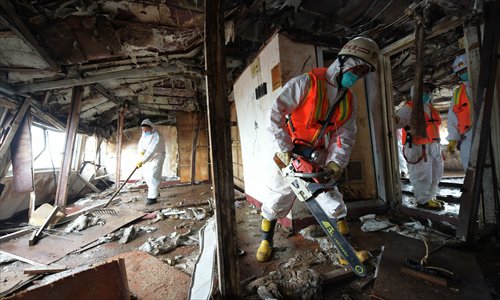Eastern Star death toll rises to 434
Modifications to ship made it harder to escape: insiders

Rescuers clean up a cabin on the fourth floor of the capsized Eastern Star on Monday. Photo: Xinhua
The death toll from the maritime disaster rose to 434 on Monday, with another eight still missing, authorities said.
The bodies of two victims were recovered on Monday morning, reducing the number of the missing people to eight, the Xinhua News Agency reported.
As of 4 pm, 204 victims had been identified after their DNA samples matched their relatives, according to China Central Television.
All cabins were sealed on Monday as rescuers had thoroughly combed the ship and failed to spot more bodies, news site thepaper.cn reported.
The four-story Eastern Star was caught in a tornado and capsized at around 9:28 pm on June 1 in a section of the Yangtze River flowing through Jianli county, Hubei Province. The incident is believed to be China's worst maritime disaster in decades.
Only 14 people, including the captain and chief engineer, survived the incident.
Industry insiders and ship inspectors said that modifications to the hull of the ill-fated Eastern Star cruise ship could have made it more difficult for passengers to escape, The Beijing News reported on Monday.
Chongqing Dongfang Shipping Company, which operates the Eastern Star and four other cruise ships on the Yangtze River, began to modify the Eastern Star in 1997, increasing the ship's length from 66 meters to 76.5 meters and sharpening the bow to reduce air resistance, The Beijing News reported on Monday.
The newspaper has questioned if the modification to the hull had made it harder for passengers to escape.
The paper cited insiders and ship inspectors, who revealed that modifying the vessel made its center of gravity unstable and increased the risk of being capsized.
A company insider said metal bunk beds fixed in the cabins were replaced with movable wooden beds while windows along the gunwales substituted for doors.
The original structure enabled passengers to escape, the insider explained.
Media also claimed that all those who managed to escape got out of the ship through the windows. Liu Deyi (pseudonym), who witnessed the entire construction process and trial sail of the vessel, added that the movable beds also made the ship capsize faster.
Although the search for the missing in the hull of the upright ship has ended, rescuers are still searching along the Yangtze River from Jianli to more than 1,000 kilometers downstream to Shanghai.
Wuhan, capital city of Central China's Hubei Province, East China's Jiangsu Province and Shanghai mobilized patrol boats and privately-owned vessels to search nearby waters, focusing on the banks, reed beds and backwaters for the missing, the Yangtze Daily reported.
Read more in Special Coverage: